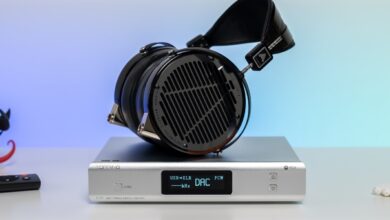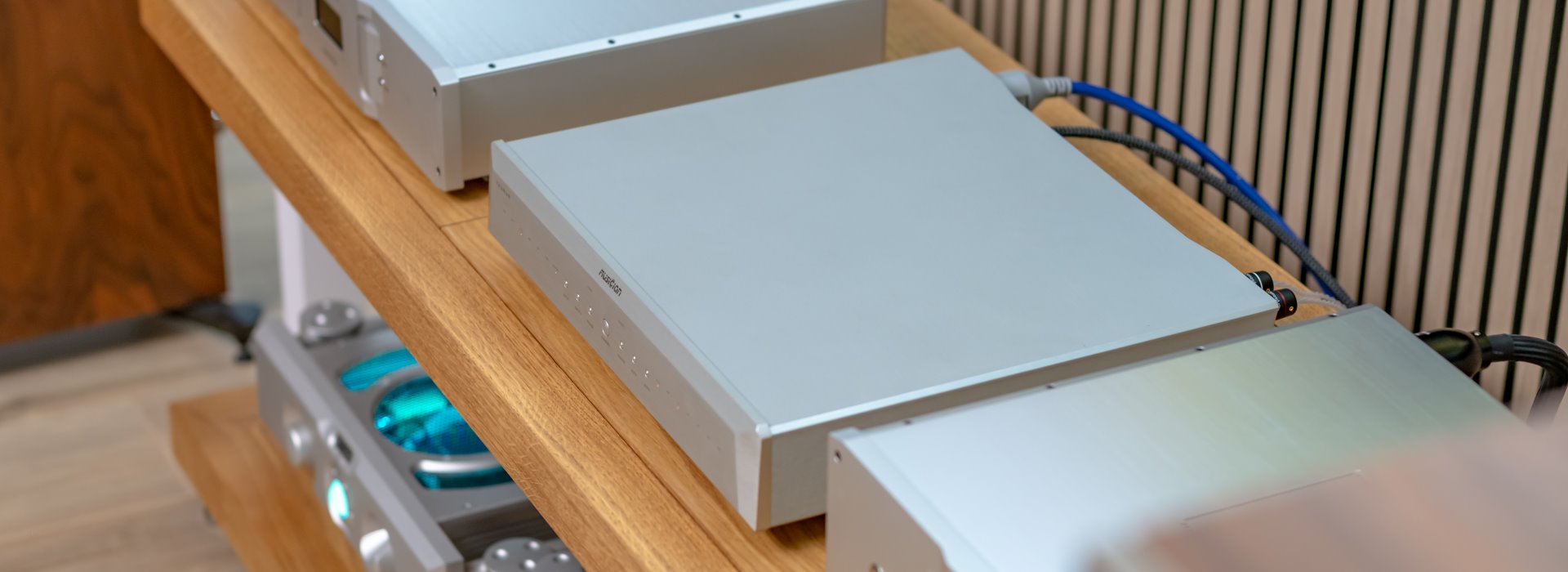
An ancient tale from eons ago spins the yarn of a Chinese brand that felt… lonely. The God of Audiophilia, recognizing this, caused Denafrips to fall into a deep slumber. Taking one of Denafrips ribs, he fashioned it into a different being called Musician Audio. Delighted with his new mate, Denafrips and Musician Audio, both naked in their innocence, experienced no shame or knowledge of good and evil (Audiophile Genesis 2:21-22).
Jokes aside, Musician Audio was born in 2020, and we were the ones to add wings and let them fly with our world-premiere Pegasus DAC review. History repeats itself, and here we are with another world-premiere DAC review. How did time fly so fast? As Audiophile Genesis predicted eons ago, they indeed share audio engineers working for two distinct audio brands. Can we blame them for that? I don’t think that would be wise. I know countless audio brands that did the same thing. Remember the team that designed the legendary Rockna Wavedream DAC exactly 10 years ago? They also designed Audiobyte’s lineup, including the upcoming SuperVox seen on the horizon. Scansonic and Raidho are sharing engineers as well, and the headbangers who brought Oppo’s lineup of planar headphones to the surface later crafted Meze Audio’s first planar driver, and the list continues. Hundreds of collaborations are intertwining audio brands sitting in the same building for decades, and that…is perfectly fine.
By chance, we tested most Denafrips D/A converters around here, and let me tell you that while they share resistors, USB modules, and the software that powers them, everything else was unique, starting with the casework, PCB design, component selection, and there is quite a difference sound-wise as well. The winged Pegasus sounded different from Ares. Aquarius had nothing to do with Venus, and their newest flagship-grade Taurus doesn’t have a step-brother in the Denafrips lineup.
Now, you probably heard about R2R DACs, discrete NOS DACs, or resistor ladder DACs. All of them describe the same working principle, but what are those more exactly? In simple terms: If you only lived in the chip-based delta/sigma domain of oversampling DACs, then this oldest breed of digital-to-analog conversion technique might change your life, forever.
If you’re looking for a DAC that would sweeten things up, add soul and liquidity to your setup, then there’s nothing better than a properly made R2R ladder DAC built to the highest standards. There are plenty of such makers around the world, some use New Old Stock chip-based converters such as TDA1541A, BurrBrown PCM63, and 1704k, while others are doing it in the most overkill way, using hundreds of high-precision hand-matched resistors, custom digital boards controlled by powerful FPGAs, squeezing the last drop of performance from their creations.
All sounds cool and dandy, but there is a problem with good-sounding R2R DACs: they cost a fortune. Many tried to make them affordable, and I believe Musician Audio succeeded with an impressive track record of price-to-performance ratio.
Their first-born Pegasus DAC impressed with its component selection, good power supply implementation, high-quality resistors, and outstanding sonics at $1100. One year later, they added not one, but two additional converters to their portfolio, challenging the notion of entry-level one last time and firing alarming shots into the high-end R2R crowd. Musician Draco is their most affordable R2R ladder DAC equipped with every possible digital input at just $750. Another year passed, and Aquarius was added to their lineup, which rocked higher-precision clocks, two FPGAs, and for the first time, four resistor ladders (instead of two) in a fully balanced configuration, asking $2899 for the whole affair. I had two concerns with the Aquarius, but those have been taken care of after two years of development with their newest top-of-the-line Taurus DAC. The voltage output is finally in line with international standards (4.3V via XLR and 2.5V via RCA), while gently boosting dynamic range versus the Aquarius. There is more than meets the eye, and I can’t wait to tell you more about it. Musician Taurus goes for $3800, and as a statement unit I’ll prepare an in-depth look at it, so let’s check it out!

Design & Build Quality
First and foremost, I’m glad that Musician Audio is sticking to a design language that’s easily recognizable from a distance – free marketing at its finest. All their creations share similar design cues, and the formidable Taurus is no exception. Housed in a thick CNC machined aluminum case, it serves as a fortress protecting precious electronics from pesky wireless interferences. At first glance, you might think the Aquarius just got a significantly larger sibling (literally), with a wider, deeper, and much heavier case than before (12 Kg vs 5.8 Kg).
The Musician team has equipped it with some of the best metallic feet I’ve seen on D/A converters, finished with silicon absorption pads that effectively neutralize micro-vibrations. The front plate boasts a thickness of 1.5 cm, and its overall structure feels rock solid and well put together – an embodiment of how a high-end DAC should look and feel. Since half of my music listening occurs in my office, where a powerful 8-antenna wireless router resides, I was relieved to find that Taurus is impervious to any nasty wireless interference, thanks to its impenetrable Faraday cage-like case.
Like most modern DACs, all the screws have been discreetly relocated to the backplate for a cleaner and more elegant appearance. Once powered, low-intensity LEDs grace the front plate, providing a subtle glow in a dark-lit man cave. I opted for the matte-silver anodized version, but if you prefer, the Musician team also offers it in anodized black. The laser engraving on the front and back panels is precise and easily readable.
The Musician Audio team opted for rounded edges, ensuring that maneuvering expensive audio equipment around it wouldn’t trigger my OCD. The front features flush buttons with a decent amount of travel and no wobbling in their sockets.
This time around, we have a much larger O-type single-crystal copper transformer (250VA transformer versus a 60VA one in the Aquarius), resulting in higher power consumption. However, thanks to the unit’s entire surface acting as a giant heat dissipator, it only warms up mildly after a few hours of use. It won’t reach the scorching temperatures of a Gustard R26 or Audio GD R7, so feel free to place anything on top, even blazing-hot integrated or headphone amplifiers.
Taurus stands as one of the biggest DACs I’ve tested around here. At 420 x 380 x 95 mm, it’s only slightly smaller than our statement DAC (Rockna Wavedream Signature). I appreciate it when HiFi equipment is hefty, robust, and well-made, hinting at a life-long performance over the years—a sentiment I’m already experiencing with the Taurus, knowing we’re dealing with 12 kilos of audiophile goodness. I’m hoping that an integrated amplifier and a larger headphone amplifier are already in development, sharing the same case with Taurus for an elegant stereo or head-fi battle station. Its dimmed LEDs draw little to no attention, blending nicely in the living room. All in all, it’s a heavyweight but sturdy unit that should stand the test of time.
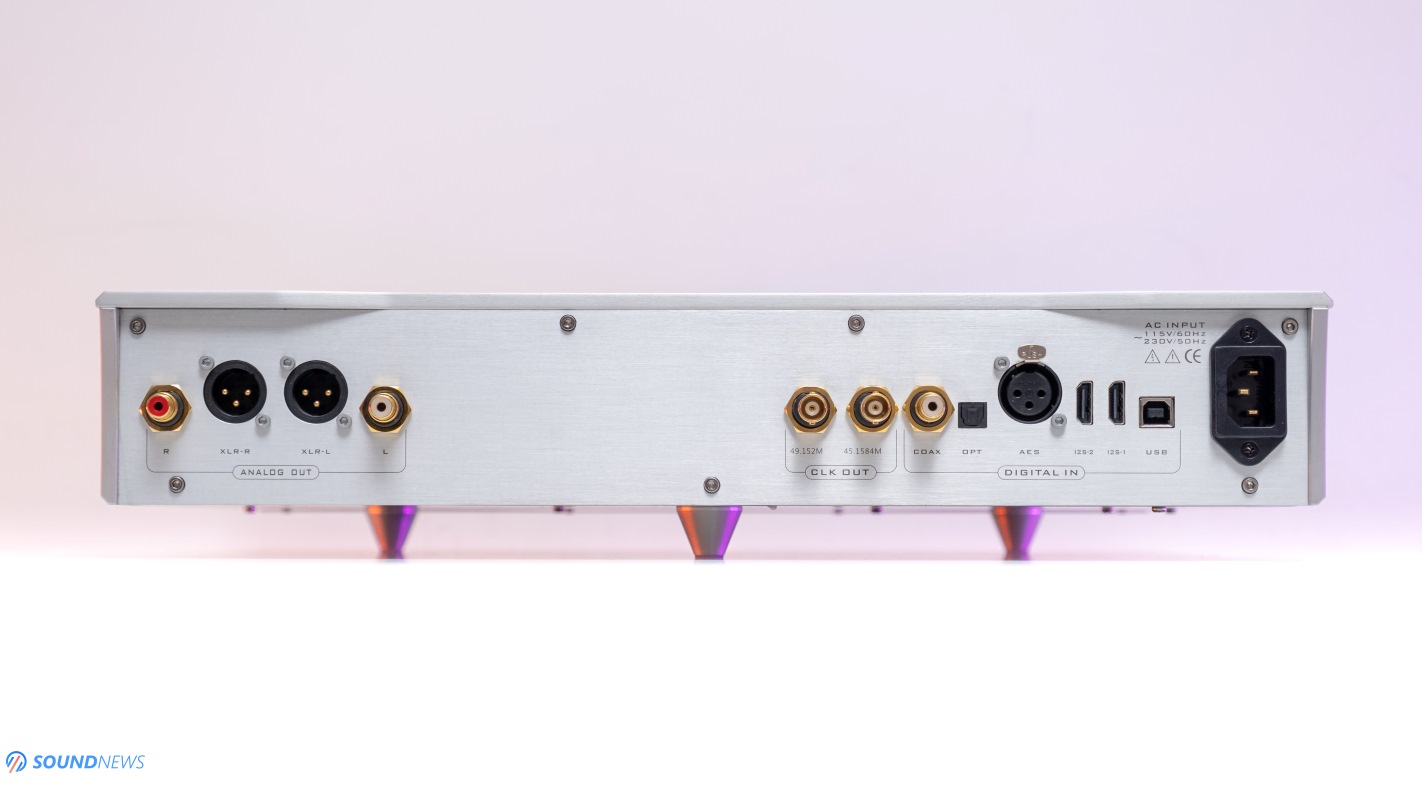
Controls & I/O
First and foremost, Taurus won’t bog you down with a complicated setup. Slap on a power cord, give the big round button on its faceplate a press, and it will gracefully power on.
Taurus keeps things as simple as its founding fathers did a year prior. Seven buttons grace its front panel, with the middle one being your On/Off button. To the left, you’ll find input selectors and a phase invert button. On the right, a NOS (Non-Over-Sampling) button awaits, ready to engage in either On (Non-Over-Sampling) or Off (Oversampling) position. Following suit, there’s a Mute and Mode button.
Musician Audio has been dangling the carrot with their Phoenix DDC, flaunting Clock outputs at 49.152 and 45.158 Mhz, and finally, we have a matching DAC that can dance to those inputs. If you crave the very best performance, then the Phoenix becomes a must-have upgrade down the line. All the digital inputs are present, featuring USB, AES, Coaxial, Optical, and two I2S inputs. Taurus is a fully balanced DAC, offering a pair of XLR and RCA analog outputs with fixed volume levels. Its signal amplitude has amped up from 3.6V on Aquarius to 4.3V on Taurus via XLR and from 1.8V to 2.5V via RCA – already an improvement, alleviating stress for the amplifier that follows.
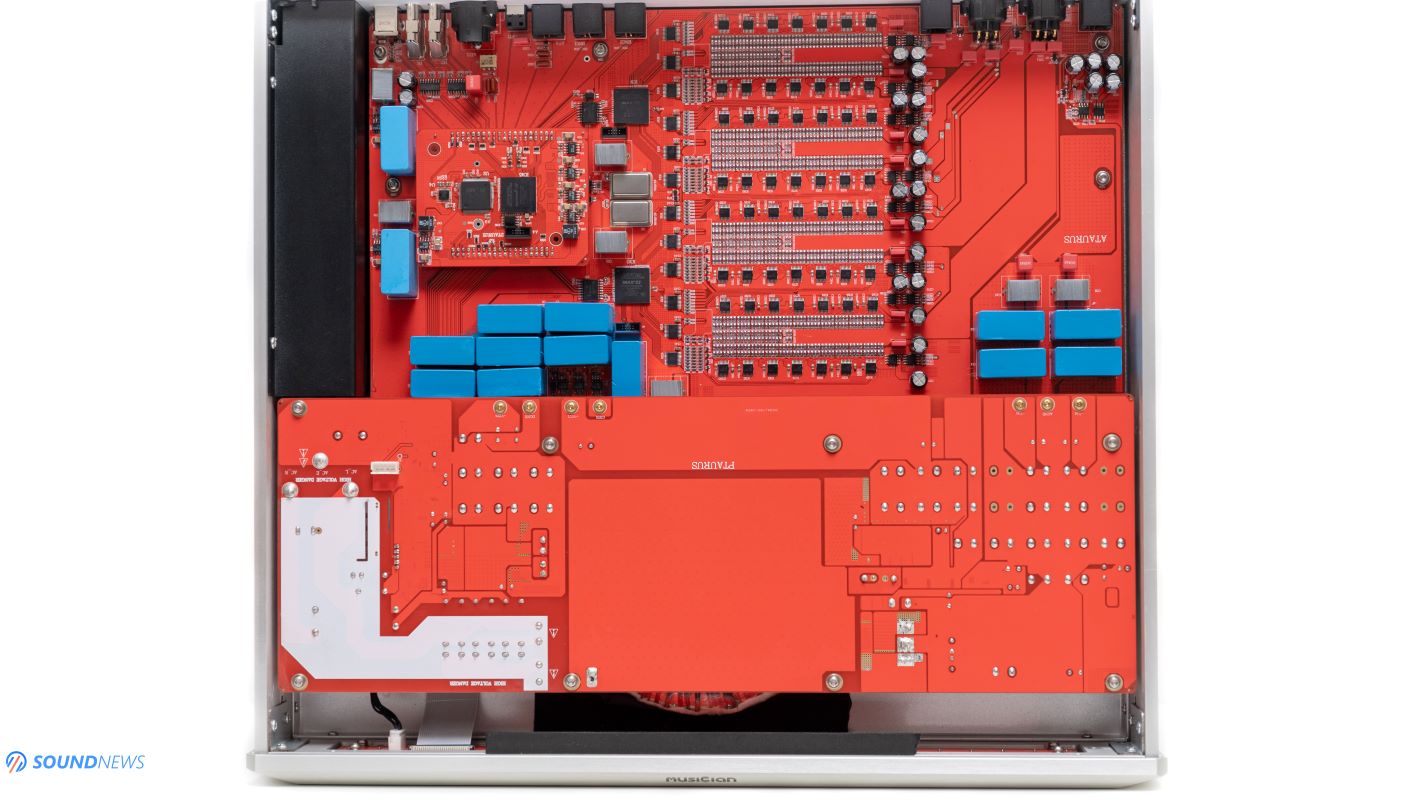
Under the Hood
Considering the custom nature of all R2R ladder DACs, it’s a rarity to find two units that look identical on the inside. Frankly, I’m getting a bit bored with chip-based Delta-Sigma DACs as most of them look strikingly similar with little to no distinctions. However, diving into Taurus’s internals, I unmistakably identify the Musician Audio signature. It whispers about Aquarius in a few key areas, but there’s a distinct upgrade with higher-quality components, enhanced capacitance, a (much) beefier power supply, a superior clocking system, and an additional FPGA.
While many R2R DAC manufacturers opt for third-party USB interfaces like Amanero Technologies, M2Tech, or the ubiquitous XMOS interface found in a broad price range, Musician took a different route. Musician’s creations flaunt a custom-made USB interface, utilizing the full bandwidth of the USB 2.0 standard – a future-proof module supporting sample rates up to 1536 kHz 32-bit PCM and DSD1024 (x8).
In the realm of R2R ladder DACs, the audio signal undergoes digital-to-analog conversion with the assistance of resistor ladders. The precision of these resistors directly influences the ladder’s resolution. Musician Audio meticulously selects thousands of resistors, handpicking only those achieving a precision of 0.005% for use in Taurus and Aquarius. The remaining find homes in Pegasus and lower-tier Draco converters. This meticulous process is time-consuming but crucial for achieving the high-grade sound that stretches wide, filling the room – a commitment evident in the finest R2R units.

Taurus houses four R-2R ladders, doubling the count found in the Pegasus and Draco. These ladders are orchestrated by an ARM CPU and two Altera Cyclone IV FPGAs, infused with custom code that has undergone thorough testing and fine-tuning over time.
On the analog side, Taurus boasts top-notch components, featuring a fully discrete input and output stage. A potent AC filter/isolator conditions the AC voltage before conversion to DC. Power is purified through ultra-low-noise voltage regulators, with DC protection circuits isolating the power supply from the circuitry.
The colossal 250VA O-type single-crystal copper transformer is meticulously filtered for the cleanest power. While a 250VA transformer might seem overkill, high-end audio has always demanded the cleanest power, and Musician spared no expense in this regard.
While I can’t capture a clear shot of the two daughterboards without a complete disassembly, it’s evident that Taurus is considerably more complex than any other Musician DAC, boasting an impressive selection of components. The layout reflects the thoughtful design and meticulous care that went into the power supply implementation. The higher capacitance compared to other Musician DACs is a reassuring sight, promising a comfortable performance.
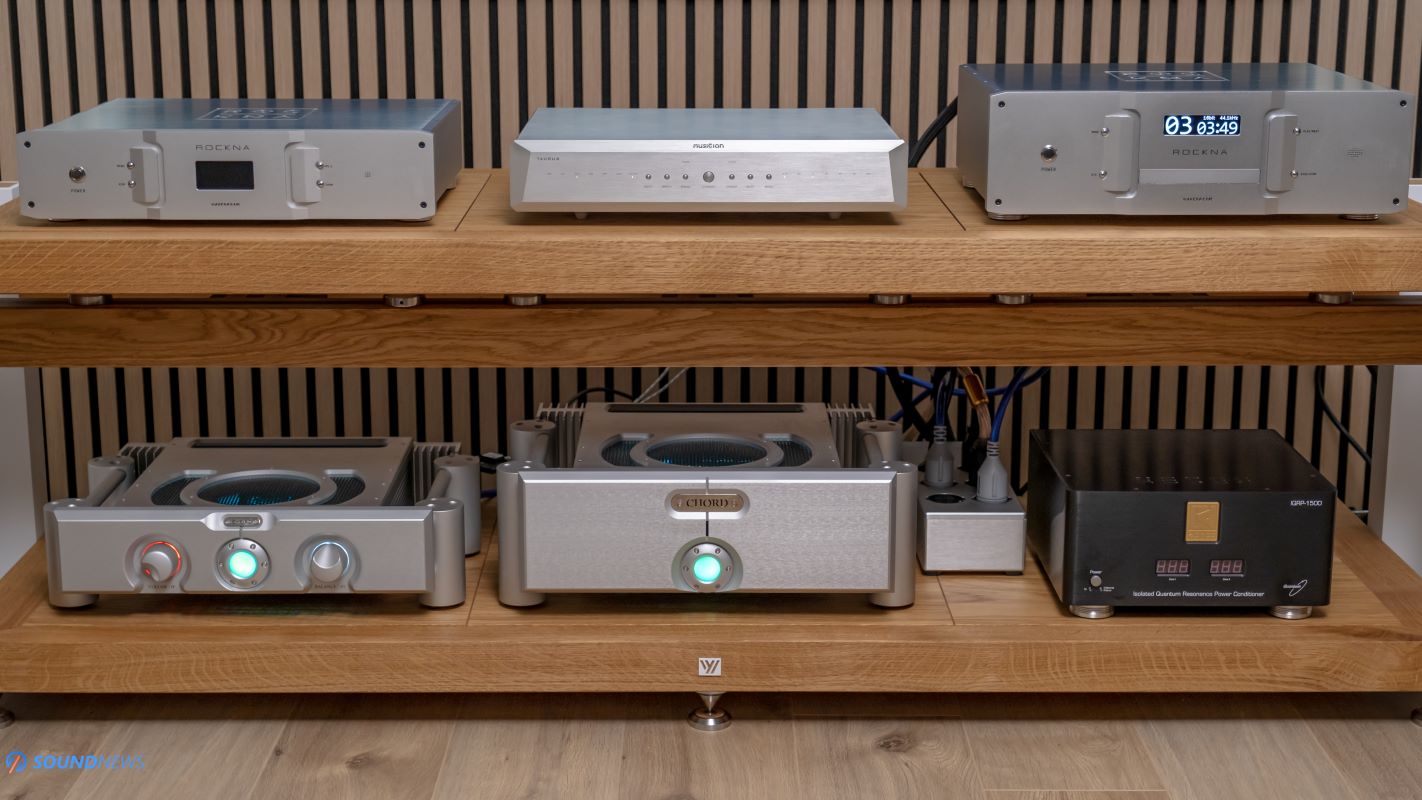
Test Equipment
The Taurus DAC showcased its versatility by seamlessly fitting into both a stereo and head-fi battle station. To put it through its paces, I employed it in two distinct setups:
- In my office, Taurus served as a dedicated DAC alongside an EverSolo DMP-A8 Roon Endpoint/Music Server/Wired streamer. Optimal performance was ensured by taking meticulous measures, including the complete isolation of the Ethernet connection with two media converters (Ethernet > Optical > Ethernet). The media converters and the wireless router were powered by a KECES S14 linear power supply. All five components were also powered by a KECES IQRP-1500 balanced and isolated power conditioner.
- Later on, I relocated Taurus to the living room, where it joined forces with a Chord Electronics Ultima 3 preamplifier and Ultima 5 power amplifier, orchestrating a pair of KEF Reference 3 loudspeakers. The Rockna Wavedream NET 4TB took the stage as the Roon server and wired streamer. All five were again powered by a KECES IQRP-1500 balanced passive power conditioner.
All right, everyone, my body and soul are ready for some well-deserved music, so let’s hit some eardrums!
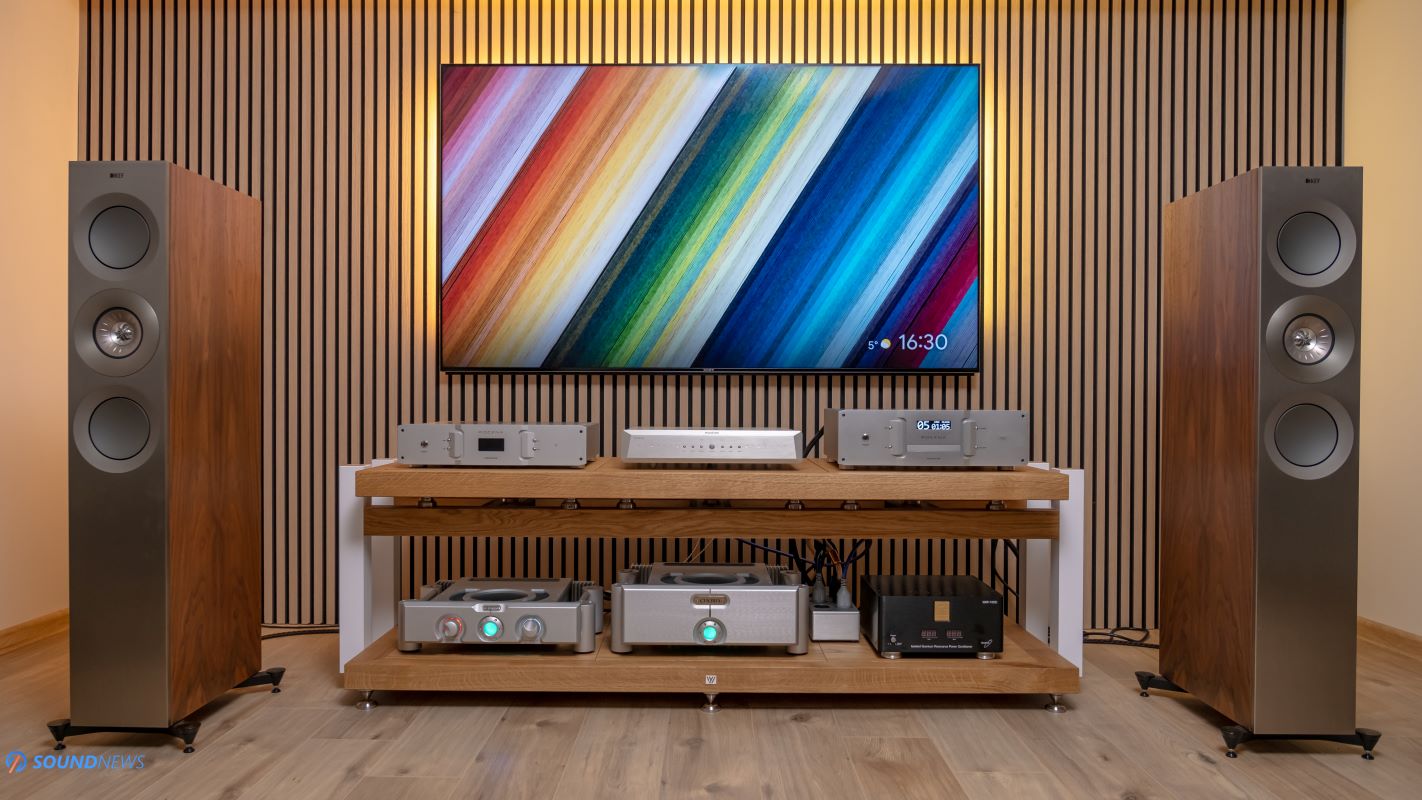
Sound Performance
I. Prologue & Preliminary Sound Impressions
Visiting the Rockna Audio factory somewhere in 2020 was a transformative event. I was so deeply entrenched in my preconceptions that modern technology would always surpass the old, whether we’re talking about space travel or audio reproduction. I met with the man behind the company and his chief engineer, who was deeply passionate about measurements, conducting hundreds of tests on a daily basis. At that time, I was using a Matrix Element X DAC, which sounded great in the system I had built around it. I let them listen to the Element X for half an hour, and their facial expressions were not pretty. “Is that all?” they asked me. “This is what you call high-end audio? This is what gives you goosebumps?”
I didn’t know how to react, but a minute later, a similarly priced Rockna Wavelight DAC began playing in the main stereo rig, and it felt like I had been living a lie for the past few years of my life. How was it possible that a DAC using the oldest digital-to-analog conversion technique could sound so fresh and modern, so effortless, and alive? It was beyond my understanding.
They later explained to me that while they run hundreds of tests every day and measure every unit they manufacture, the final tests always take place in their dedicated listening room. Some people still believe that measurements are the bread and butter of a DAC, but they should remember why we’re doing this in the first place. I spend my hard-earned money on exquisite experiences, not on numbers on a screen. I want to stand and applaud, ideally once or twice a day, when something truly moves me. This hobby is probably not about the final destination but about our journey to experiment, learn, and find balance until everything plays exactly as we envisioned it.
Returning home with a HydraVox in my hands (part of their sister company Audiobyte) and later extensively testing a Rockna Wavelight R2R DAC in the comfort of my home, I swore to myself that I would study everything related to resistor ladder and FPGA DACs from that moment on.
Today, after trying dozens of such converters, I’ve settled on a Rockna Wavedream Signature and Chord DAVE DAC, covering a head-fi rig and a stereo rig to which I dedicate most of my free time. Living with the Wavedream Signature for over a year was also a transcendental experience, as finally, the music wasn’t only about tonality or “meat on the bone”; it was also about spatial cues, tridimensionality, unlimited depth, and sound that could go beyond the borders of my listening room.
Returning from the Warsaw Audio Show and seeing that the vast majority of high-end systems used a vinyl rig, an R2R DAC, or oversampling tubed DACs, all of which brought forward so much emotion, presence, and smoothness, while simultaneously untangling the music like I had never experienced before, was a clear sign that above all and everything, the oldest technologies sounded most natural to our ears, while the newest have a digital vibe attached to them – a distraction or vibration that isn’t aligning with our internal clocks. When I was returning home, I didn’t want to power on my system, as I knew I wouldn’t get the same overflowing naturalness. My beloved informed me that a large package had been delivered while I was abroad. I started ripping it apart and saw a massive Musician Audio DAC, bigger and meaner-looking than anything they had done before.
I wasn’t in the best of moods, still haunted by the lifelike experiences we had at the Warsaw Show. “What the heck?” I thought. “Let’s give it a try.” I connected it to the Wavedream NET Roon server via I2S, followed by a Chord Ultima 3 preamp and then Ultima 5 power amplifier, and started listening with a coffee in my hand.
The inaugural Doors album, remastered at the highest quality began playing, and I exclaimed, “This Is It!” This is the sound I heard at the Warsaw show – that big, holographic, and completely 3D sound that enveloped our bodies. The warmth coming out of that thing was overflowing. The sweetness surpassed my very best DAC, Taurus while crazy in its dynamics delivery, was above all and everything: a very smooth, organic, and holographic-sounding unit.
I tried a good deal of units that were putting a higher accent on the textures, on the so-called meat on the bone, but the Taurus puts that on a pedestal as its most esteemed skill. My Wavedream Signature isn’t as smooth and organic, nor as big-sounding, and the difference was definitely there, and it wasn’t a small one. The Wavedream was more dynamic, clearer, more resolving, and explosive sounding, all while having better control over all frequencies. The Wavedream was more transparent and honest; it’s undeniably a better DAC in every aspect, but the Taurus was made from a different cloth. It was making me dance and feel every beat of the music. It wasn’t providing the last drop of information, and the music wasn’t charging as a raging bull like the Rockna does, but I became calmer; my day suddenly became brighter.
I started listening closer to Warsaw’s playlist (give it a try), and sure enough, the sound started pouring down on me. The naturalness was overpowering any other feeling. I couldn’t think about anything else, really, like somebody magically swapped the Taurus with a really good turntable playing a first-press vinyl. Crowded tracks that usually make me press the fast-forward button, were no longer doing that. My listening chair went from the 10th row in the auditorium to the last row. The performance grew in all dimensions, and honestly, this is one of the biggest-sounding DACs that I have experienced so far. If soundstage, depth, and stereo image are extremely important to you, then Taurus untangles everything so easily and then adds some space where there was too little of it. While not as technical and clean-sounding as my main DACs, it is definitely playing bigger than both the Rockna and Chord Electronics creations. The sound isn’t just coming from different angles, but it’s always floating at different altitudes. Wait until you experience all of this via headphones; you won’t believe headphones can do such things on big orchestras and live recordings.
I’m not sure if I’m ready to give up my Wavedream Signature or Chord DAVE yet, but the Taurus has definitely made me reconsider my stance on R2R DACs. It’s a truly special piece of equipment, and I can’t wait to see what else Musician Audio has in store for the future. In the meantime, I’m going to keep listening to music and enjoying the Taurus. It’s a reminder that sometimes, the simplest solutions are the best.
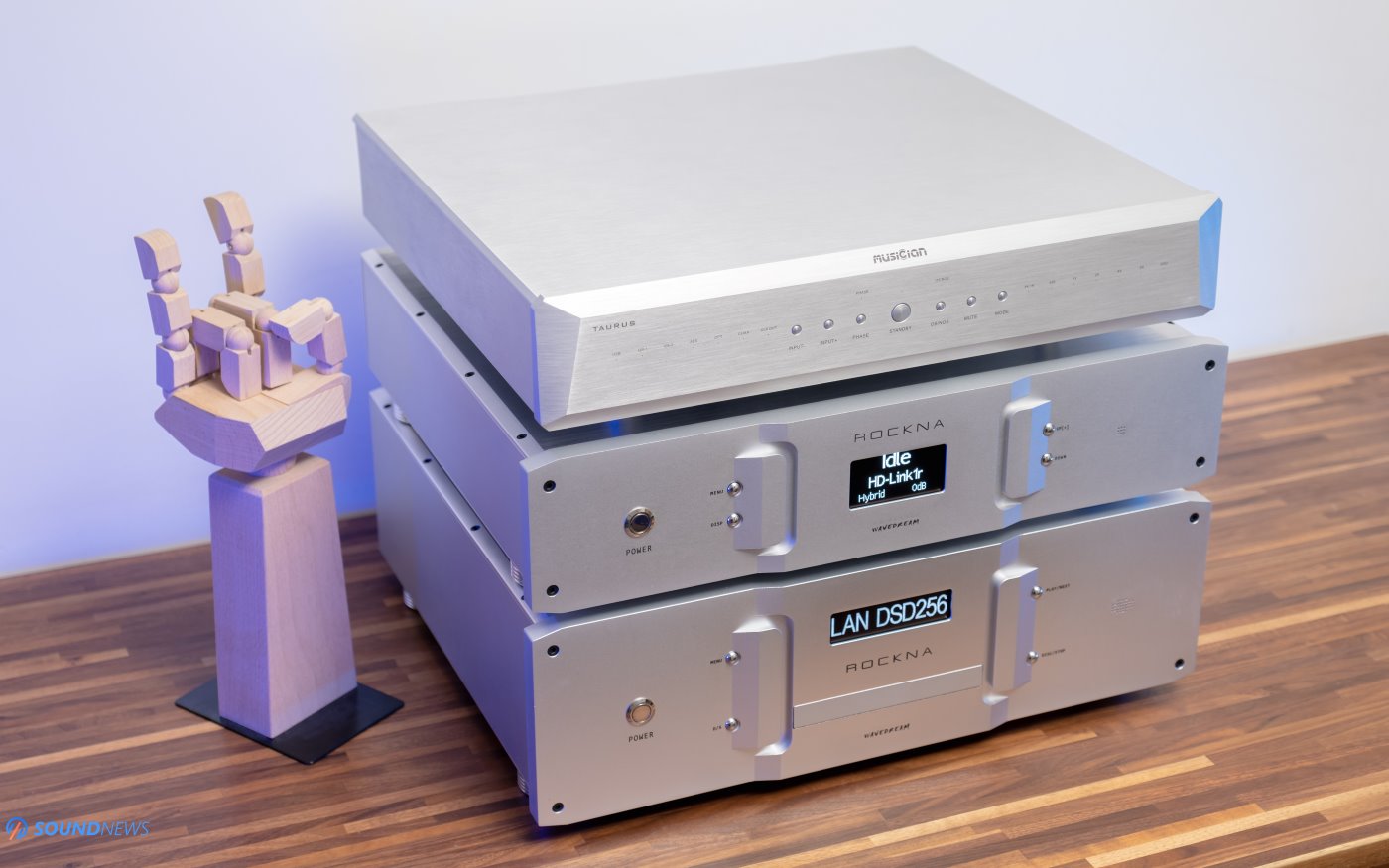
II. Soundstage & Stereo Imaging
The second and third chapters of all my reviews always focus on the strongest skills of the unit being reviewed. For Musician’s Aquarius, it was transparency and resolution that impressed me first. On the Gustard R26, it was the transient response that was mercifully pushing and pulling dynamics. But on the Taurus, it is the soundstage that makes it special and quite different from everything else I’ve tried.
For fun, I connected the Taurus to a 15-kilo beast that was designed to empower headphones and nothing else, the beautiful Trafomatic Primavera. It was receiving the signal from the Taurus and then driving a pair of HiFiMan Susvara headphones. Although I’ve had the Susvara for more than two years, I could finally see their true potential. The first year with them was a love/hate relationship, and bringing the best out of them was one of the hardest tasks I’ve ever had. The Primavera, however, solved every issue I had with them: weak dynamics and a small soundstage were the first ones I wanted to fight back.
I won that fight two years later, but it cost me dearly – lots of time and hard-earned money to make them sing. Although I’m now in love with them, the Susvara do not have the widest or the deepest sound no matter what you do. You can’t beat physics and acoustics combined; a small driver will always produce smaller sounds compared to a bigger driver. I won’t use bigger-than-life words, but the Susvara never sounded as spacious before.
Spatial cues slowly started drawing a colorful picture in front of me. Arcoiris by Porangui (Qobuz / Tidal) portrayed a beautiful soundstage around me. It wasn’t just generous in size; it was massive in every meaning of the word. I’m still scratching my head about how a pair of headphones can sound so…speaker-like. The acoustic guitar and the flute started playing tricks on me, jumping from left to right, from front to back, and then to higher altitudes. It had a kind of layering that made me easier focus on each instrument individually. It didn’t rush things as the DAVE sometimes does; it was slower in its presentation, and that worked in its favor, especially on this tribal folk music that awakens something inside every time I press play. This simple track didn’t utter a single word and yet it changed my state of mind and made me think about Mother Nature.
Next, Dies Irae (feat. Vila) by Nattura (Tidal) started playing, which for no reason reminds me of the conflict in the Middle East. This track makes me think about my sister and her family living in Israel. I tried holding my emotions, suppressing them, but I can’t deny that the Taurus was somehow amplifying them. Sorrowful music makes you even sadder, and happy tunes make you jump and dance all around. Something deep inside it is boosting the color of the music; the textures are considerably more powerful, more vivid, and more alive. This DAC is the direct opposite of an oversampling delta/sigma DAC that removes a good deal of texture and soul of the music. Taurus brings back lost emotions and lets them shine brighter. I’m usually not that emotional when describing what I’m hearing, but the Taurus was definitely cut from a different cloth. I find it considerably more technical than their Pegasus, slightly more so than their Aquarius, but it’s a different animal when describing the grandness and layering of the music. It’s playing in a different league in these departments, and I’ve yet to hear a DAC that outperforms it here. Soundstage and depth? Easily a 10 out of 10!
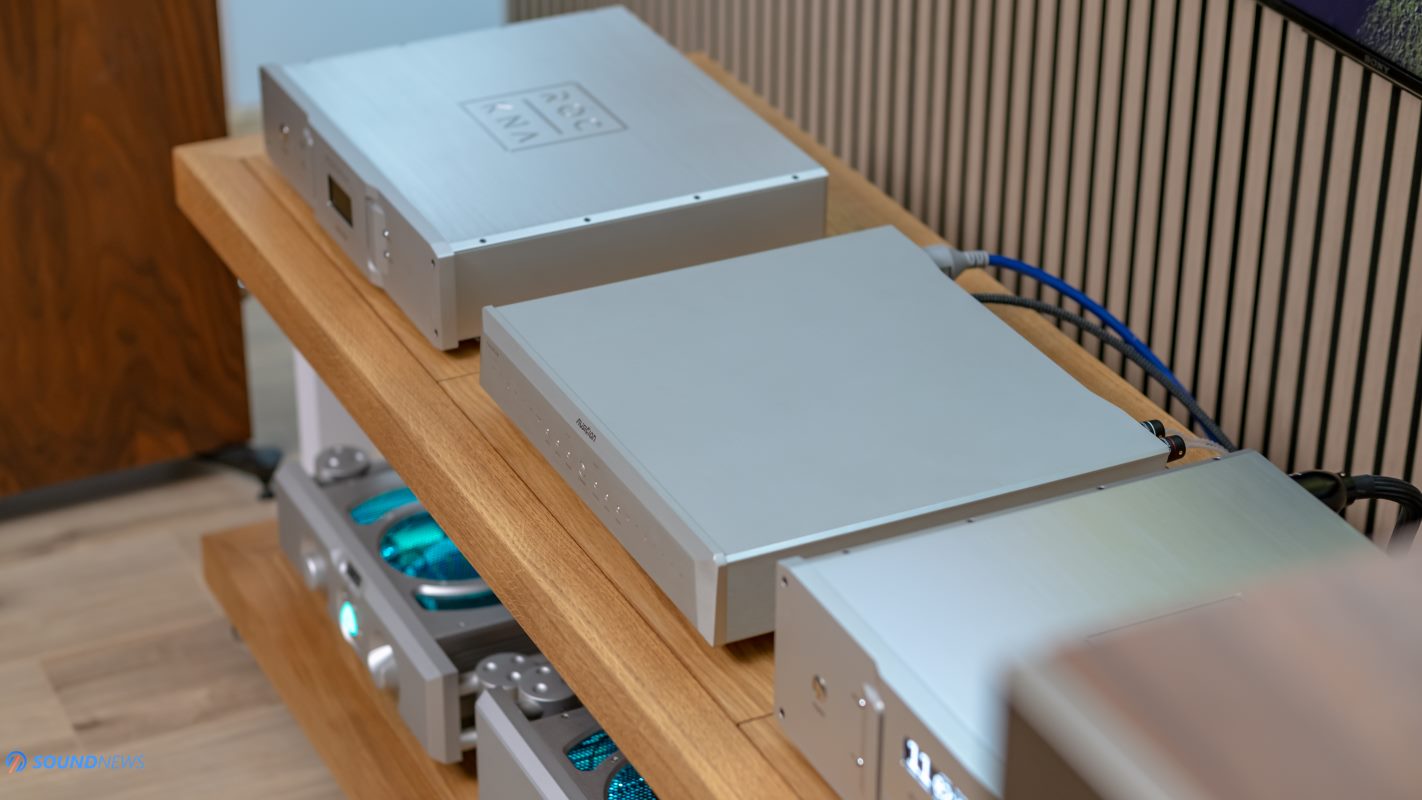
III. Dynamics & Transients
To tell you the truth, timbre, and texture are probably the most important qualities a digital-to-analog converter should possess. A violin doesn’t need to sound like a viola, and a genuine saxophone doesn’t need to sound like a Sax-A-Boom. Sadly, I’m no musician (Taurus is), and I can’t rely only on live performances I’ve attended throughout the years; however, I have a different measure for such things. Every. single. time. when something sounds natural, smooth, and organic, I will reach out and raise the volume. Higher and higher. Is this divine intervention or a sign from below? It’s a sign that every note follows the proportions of the Universe that surrounds us. I never stop at one listen; a second one always follows, another listen, and of course, another track, raising the volume even higher.
This happened so many times with the Taurus that I lost count. In the evening, I wondered why my ears were ringing, forgetting how I was unintentionally raising the volume above safe listening levels. But it sounded so good, so lively, and easy-going, I simply couldn’t resist going louder. Brightness, harshness, and listening fatigue are words that will never linger in the same sentence with Musician Taurus. It’s devoid of such things, regardless of whether you’re a headbanger who likes overly distorted music or a blues toe-tapper.
But there’s something else that compels me to raise the volume and those are dynamics. When you hear the slap of the fretboard, the snares kicking you in the chest, the haunting voices coming from the corners of your listening room, then you start craving for more of that, more dopamine, and more drugs for your soul. Making incredibly punchy and hard-hitting R2R DACs is complicated because everything inside them works against speed and impact. Having hundreds of resistors that are switching on and off, decoding every bit individually, is a complicated task that puts some distance in the signal path. The signal walks a much longer path compared to, say, an oversampling chip-based delta-sigma DAC, meaning that the sound should also be slower, less impactful, and not as accurate in terms of timing.
Lower-grade R2R converters are indeed slower-sounding, and many of them won’t do proper justice to modern electronica (*cough Denafrips Ares / Musician Draco cough*), but once you go up the ladder price-wise, additional electronics will be used to counterbalance these issues. Additional FPGAs before the R2R ladders, like the Aquarius and Taurus, have, some manufacturers are adding secondary FPGAs after the R2R ladder trying to reconstruct the timing (Rockna Wavedream does this), stronger and bigger linear power supplies are also used that will push clean power to crucial digital and analog sections, and there are additional steps that are trying to improve the timing and the transients.
Taurus (as its name suggests) sometimes feels like a raging bull charging forward when the right music goes wild, especially after ~20-30 minutes of warm-up time. The Rockna still reign supreme in this regard and as a transient response guy; I will probably die with a Rockna by my side, but I can’t deny the impactful nature of the Taurus. Lower-grade R2R DACs are mostly mellow, laid-back, overly smooth, and slow-sounding, but that isn’t the case with the Taurus. The natural textures remained intact, and the massive soundstage is still unrivaled, but dynamics are this time around punchy and powerful. When coming from an oversampling delta-sigma DAC to Taurus, it almost feels like the music is twice as heavy, the voices are twice as guttural, and the sound is two times closer to a live performance. I wish this would be an exaggeration on my part, but there is none. Dynamics are running wild on the Taurus; the bass is bolder than that of the Pegasus and Aquarius, and it stands out. The bass and midrange are the ones that are screaming for attention and appreciation.
But there is more than just dynamics, speed, and final kick; there is also an equally important skill: effortlessness.
Maybe we can’t hear effortlessness, but we can feel it—the ease and calm that make you relax and focus on beautiful things like music. Time seems to glide by effortlessly when you’re listening to it. Oftentimes, it surprises you with a slow build-up followed by an explosion of sound, an expansion that it tries to maintain steadily. Now imagine that after relaxing every muscle in your body, a big drum drops like a bomb and you leap two meters off your sofa. When effortlessness and powerful dynamics reside in the same unit, that’s exactly what you’ll get. The Musician Taurus earns a perfect 10 out of 10 for effortlessness and a solid 9 out of 10 for transients as a whole.
I don’t usually listen to psytrance on R2R units, but when Mandala by Blastoyz (Tidal) started hitting my eardrums with an unstoppable force worthy of the Taurus name, the needle on the Trafomatic Primavera went berserk, hitting the 0 dB mark twenty-four times per second (figuratively speaking). It handled and maintained the lowest octaves with such ease that it was clear to me that the Taurus can and will do proper justice to electronica and anything else that has to do with dynamics and bass slam.
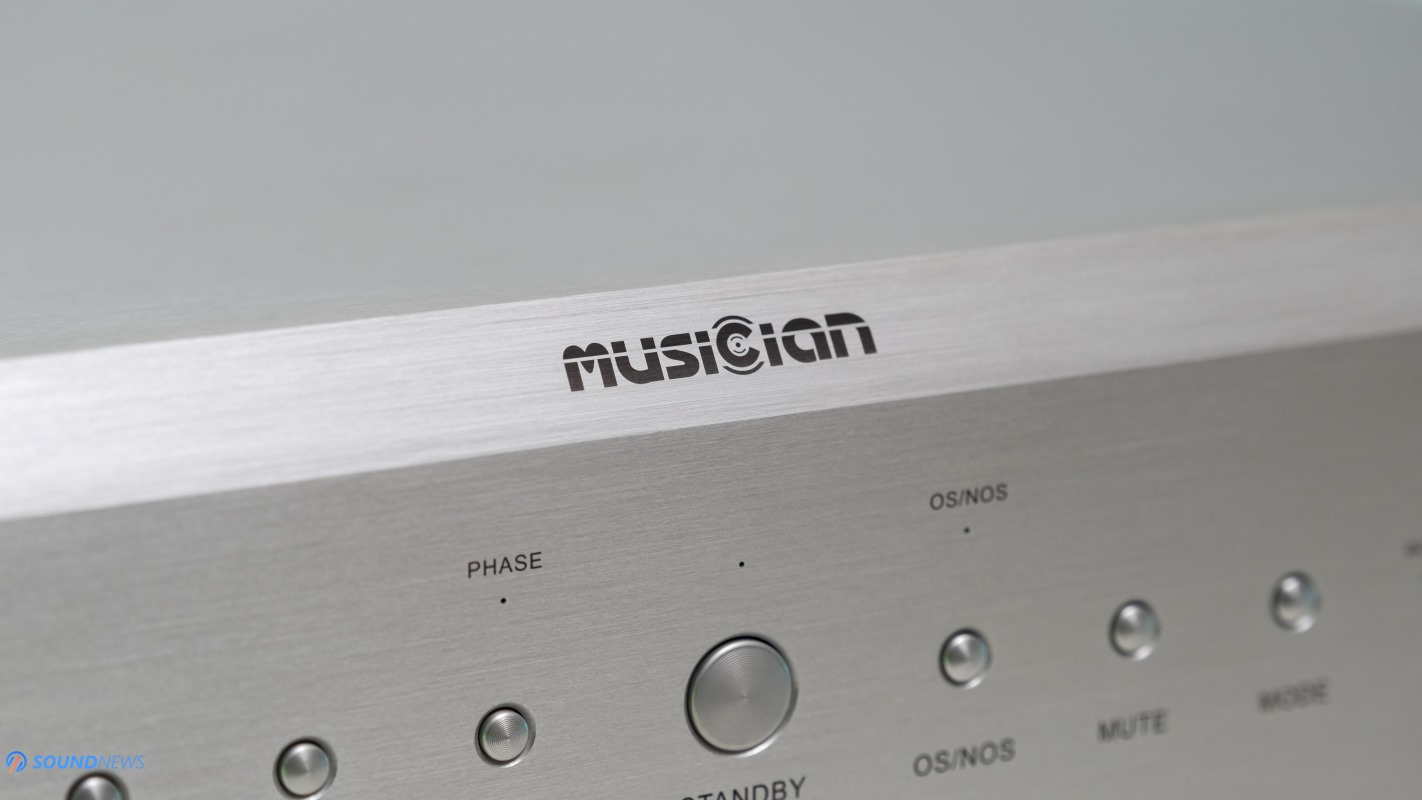
IV. Resolution & Transparency
While Musician Audio meticulously measures their units with audio analyzers, I measure them with my ears and believe me, it’s not as complicated as it might seem, especially after acquiring high-end electronics that no longer bottleneck the final performance. Here’s a brief history lesson: chip-based converters were created to lower the cost of making stellar-performing D/A converters. Oversampling delta-sigma DACs were made to cut costs while trying to surpass the founding fathers in terms of dynamic range and resolution. But did they achieve that? Partially. Yes, they are considerably more affordable! You can get decent-sounding units for even around $200, thanks to Chi-Fi converters that are (still) overflowing the market.
However, once I heard the Wavedream Signature and the DAVE, I realized that there is still a long road ahead before chip-based converters offer the same transparency of sound and the same see-through performance. Resolution is catching up, but transparency and layering are still not quite there yet.
Bright minds are slowly counterbalancing these issues (Ferrum Wandla is a very good example of thinking outside the box), but the final result won’t be a $300 one, but more like somewhere between $3000 and the sky is the limit. Musician Audio added higher precision clocks to the Taurus, we have an additional FPGA compared to their Aquarius, and the overall component selection is nicer. The hardest task ahead of an R2R DAC is maintaining the resolution as high as possible, followed by the timing and speed of the sound. The resolution can be killed by lower-grade components in the signal path… or even with two resistors that don’t match the precision of the rest of their brethren. Now imagine this: there’s a guy in their company who is manually measuring every resistor. The best-measuring ones are going into Taurus and Aquarius, and the rest are being used in the Draco and Pegasus. Sadly, transistors, like everything around us, might look identical, but they perform differently. My son looks like me, he likes sweets and watches movies in the evenings with his parents, but who am I kidding, he’s a very different person. Resistors have the same fate; they don’t have individual names as we do, but they perform differently, and I’m curious if the best-measuring resistors are getting their names.
Hey Frank, what’s your score? 0.005% precision…Cool, you’ll be riding the Taurus soon. What’s yours? 0.01%…meh, Draco is stamped on your forehead.
Jokes aside, Taurus is playing in a higher league compared to their Draco, Pegasus, and Aquarius. And the thing is, you won’t need a day or even an hour to hear the extra information coming forward. Sadly, impressive detail retrieval in R2R units is synonymous with expensive. Taurus isn’t exactly affordable, but it isn’t very expensive when comparing it with its competitors. $3800 can be a fortune for some and peanuts for others, but I honestly believe they priced it a little lower given the performance I’m getting in return. I’m still wondering why I’m placing this chapter in flagship D/A converter reviews, but being me, I’ll always try to offer you more and go the extra mile along the way.
No Worries by Amateur Blonde (Qobuz / Tidal) is, on the surface, a very simple track. You have two guitarists interplaying; you have the main stage and some backing vocals that are adding some atmosphere. But if you engage your zooming skills, there’s more than meets the eye. First and foremost, all the magic is done by a single man, a one-man band. Thanks to modern recording and mixing, you can record your voice and then add backing vocals that also show the same face in the mirror. Ryan’s voice is floating on the surface, but there’s so much more music behind his voice, including a piano and two guitars that aren’t losing their energy. Small details are starting to pop up all around, populating your listening space.
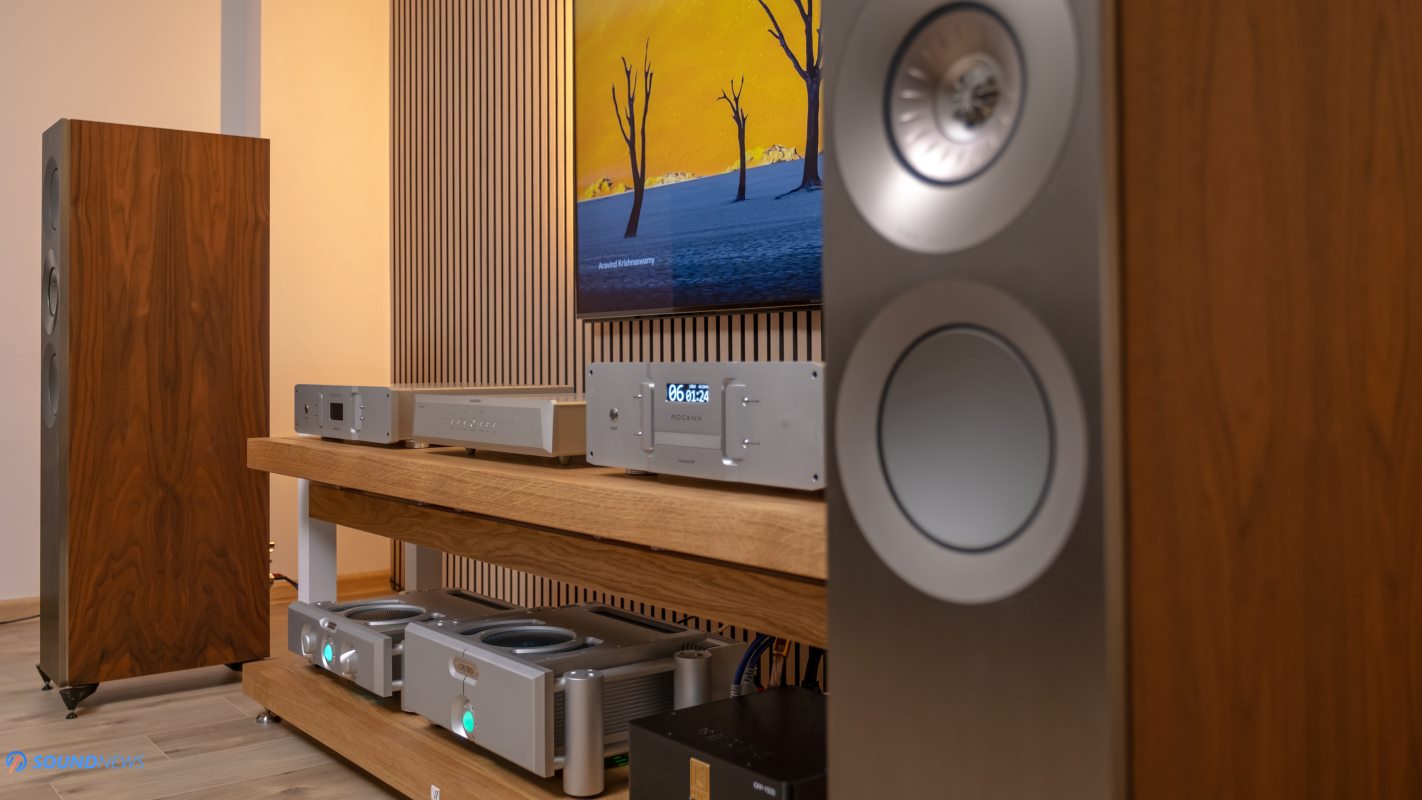
V. Musician Taurus in a Stereo Rig
Like its predecessors, the Taurus doesn’t offer additional features beyond decoding a digital signal into an analog one. It lacks volume control and preamplifier functionality, which is a common trait among R2R units. It provides a fixed voltage output of 4.3V via XLR and 2.5V via RCA, which is higher than the output of the Aquarius, Pegasus, and Draco.
For a straightforward setup, you can connect the Taurus to an integrated amplifier that will drive your loudspeakers. If you prefer greater control, you can opt for a preamplifier and power amplifier combination, which could theoretically offer better overall performance. I currently use a Chord Ultima 3 preamplifier followed by the Ultima 5 power amplifier, a combination that has outperformed many other preamp and power amp combos I’ve used in the past.
While some of the latest oversampling DACs with delta-sigma modulators offer volume control, eliminating the need for a dedicated preamplifier, most of them use simple digital attenuators that reduce the voltage and consequently the volume. Without using actual line-amplifier circuits, these units compromise the outcome, lowering the signal strength and even losing bits of information. When faced with the choice between a DAC with a fixed voltage output and one with a mediocre volume attenuator, I would unequivocally choose the former.
Lacking a volume control isn’t as inconvenient as it might seem. You can always add a proper active preamplifier like Musician Audio’s fully balanced class-A Monoceros. If you seek even more warmth and smoothness, a tube preamplifier might be the ideal choice. And if your budget is tight, an affordable passive preamplifier can do the trick. None of these options will degrade the resolution or signal purity of your source.
Connecting the Taurus via I2S from the Rockna Wavedream NET to the Ultima brothers made in Kent, UK, transformed the KEF Reference 3 loudspeakers, making them sound like a pair of Reference 5 with two additional woofers. The low end didn’t extend lower, but the soundstage suddenly became taller, wider, and deeper, as if the room had expanded. It’s still a mystery to me how a single DAC swap can create such a vast expanse of air between the notes. In mere seconds, the sound picture evolved from amazingly big to three-dimensional, as if my stereo setup had been replaced with a Dolby Atmos system. This is what people describe as holographic and laid-back sounding.
The Taurus soundstage was larger, wider, and deeper than any other converter in my collection, including much pricier ones I’ve acquired over time. I experienced a similar transformation when I moved to my office, where the Taurus became the centerpiece of a headphone setup. I recall my astonishment when I added the Chord Ultima 3 preamplifier between the Chord DAVE and Ultima 5 power amplifier; I couldn’t believe how much air it filled the room and improved driver control. Replacing the DAVE with the Taurus made the music seem more at ease, more relaxed, and refined, albeit not as fast and furious as the DAVE. The resolution and driver control decreased slightly, but the midrange presence and body were enhanced. At these price levels, it’s no longer about which converter is better, but which one better suits your preferences. It’s reassuring to know that a $3800 DAC can still hold its own against a pricier competitor and even teach it new tricks.
KEF’s aluminum drivers always benefited from a breath of fresh air in the soundstage department, an added smoothness, and a higher presence in the midrange region for a natural sound. It takes some effort to tame those aluminum drivers, but I’m pleased to report that Musician’s Taurus is the perfect remedy, taming their peak trebles and infusing more life into the bass and midrange. Simply put, the Taurus performed flawlessly in a stereo setup, delivering high resolution and an incredibly natural sound.

Frequency Response
VI. Bass
Bassotronics enthusiasts will rejoice in the heavier, more textured bass response delivered by the Musician Taurus compared to regular delta-sigma DACs. The Taurus infuses your speakers and headphones with an abundance of bass energy, adding a touch of oomph and presence to every region of the frequency spectrum, not just to the bass. However, the lowest octaves truly shine on this unit, and if you’re upgrading from a Musician Audio sibling, then Taurus will undoubtedly provide more mass and density in the low end.
Initially, the bass might not feel super clean or refined but fear not. With its much larger O-core transformer and a significantly higher component count compared to the Aquarius, you should expect the sound to fully blossom within a week at most. Additionally, tens of resistors need time to properly settle in. While I didn’t experience any major shifts in overall tonality, the bass transformed from muddy and unrefined to clean and defined within ~three days.
In terms of quantity, the Taurus roams the territory of the Gustard R26, delivering a higher sound pressure level in the bass even on light and ethereal music. However, in terms of quality, the Taurus’ bass is cleaner and more resolving than the R26. It does proper justice to modern electronica and, I’m confident it will handle everything else with equal finesse, delivering powerful, sustained, and naturally decaying bass notes.
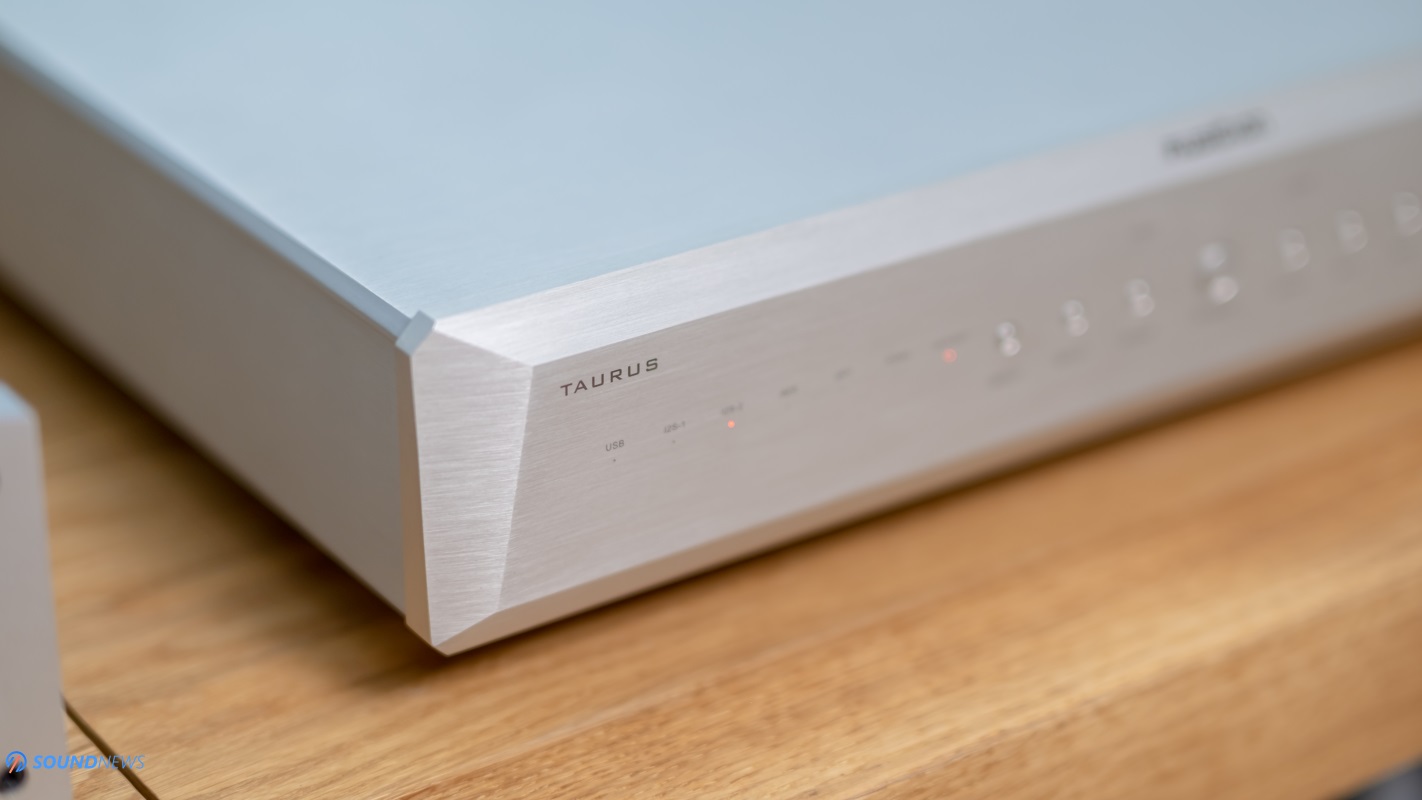
VII. Midrange
Hurdy Gurdy? Tutti Mondi! Prima Nocta’s Baudica (Qobuz / Tidal), Fuimadane’s Framkvæmd (Qobuz / Tidal), and Heldom’s Knoglesang (Qobuz / Tidal) are songs of glory that awaken memories of a past life, all heavy hitters in the midrange department. The hurdy-gurdy, violin, viola, double bass, and throat singing all leave their mark in the midrange, breathing life into these powerful tracks. If Framkvæmd doesn’t send shivers down your spine at high SPL, then you should double-check your electronics. But if Norse Gods suddenly appear before you offering you a pint of ale, then you know the midrange is doing its magic.
After a series of encounters with the all-knowing Odin, it became clear to me that the Taurus not only elevates the midrange above the rest of the frequency response but also beautifies it. It makes it real, soothing, powerful, and very zingy. Sound vibrations become longer, stronger, and a bit scarier. These three bands exude an eerie feeling of “legendary” and “epic,” with old-skin drums and ritualistic hums that echo even after pressing stop, all happening in the midrange. And I must say, the Taurus never let me down with its sweet, inner voice. The Aquarius and Pegasus also deliver quite a sweet and organic sound in this region, but the Taurus boosts that energy further, adding additional mass and air around the notes. Heill Óðinn!
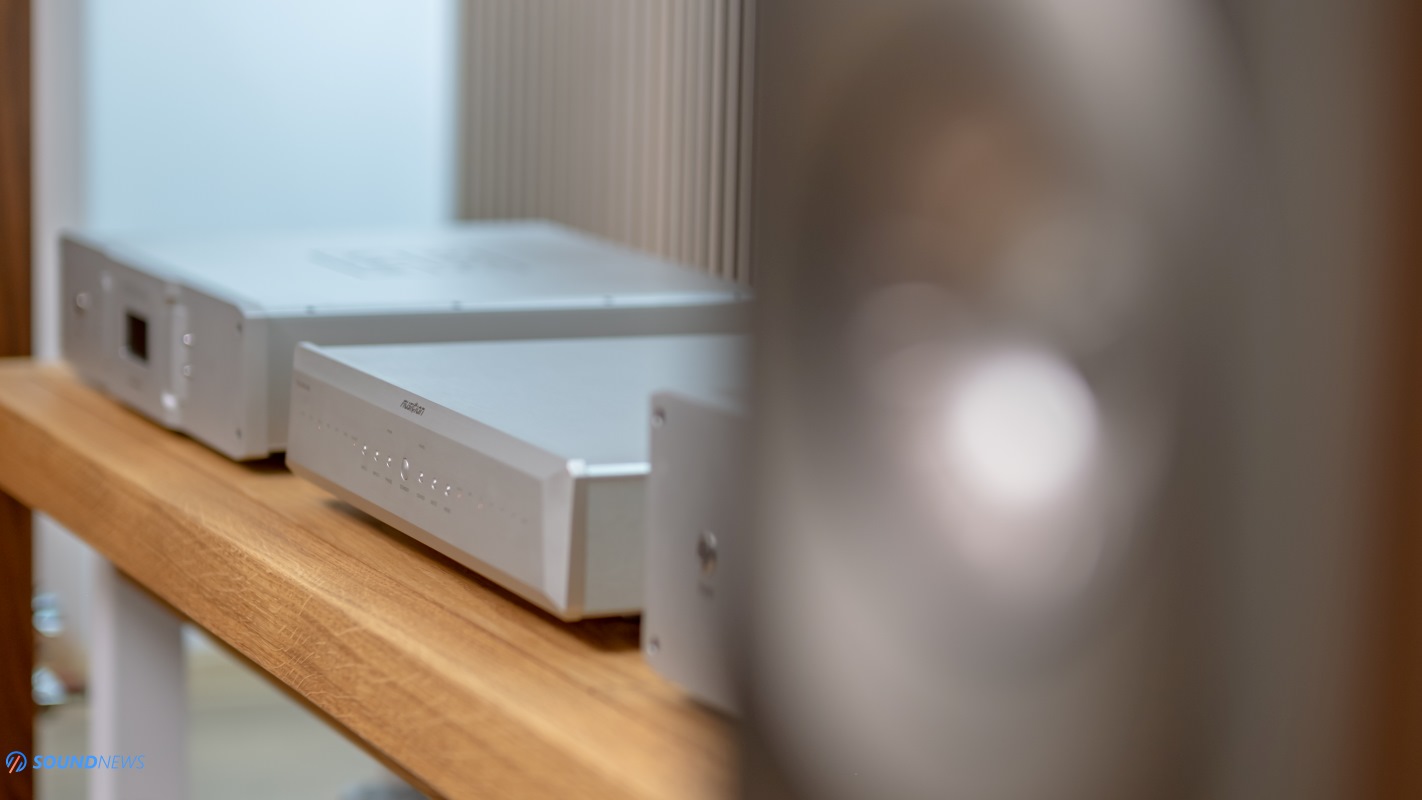
VIII. Treble
Treble enthusiasts can rest easy (this time around) as the treble isn’t rolled off as was the case with the Draco and Pegasus. I can only assume that the higher precision clocks and additional FPGA chips are maintaining higher resolution while ensuring better control over the frequencies. The sound is as detailed as it can get, and the treble plays its ace of spades, bringing textures, lots of body, and shimmer, but without any brightness or listening fatigue. To be completely honest with you, I don’t recall reviewing a DAC in 2023 as natural and easygoing in the treble. After wrestling with folk metal tunes for over a week, the secret of the runes wasn’t revealed to me, and I gave up the fight. I can’t make it aggressive no matter what I do, and if aggressiveness and super strong leading edges are what you seek, then it’s a better idea to check out a delta/sigma oversampling DAC.
The digitus never showed its ugly face, and overall, this is one of the most easygoing units I’ve tried as of late. Pair it with a tube amplifier and milk and honey would be pouring all over your face, maybe too much of that. Remember, system matching is still essential.
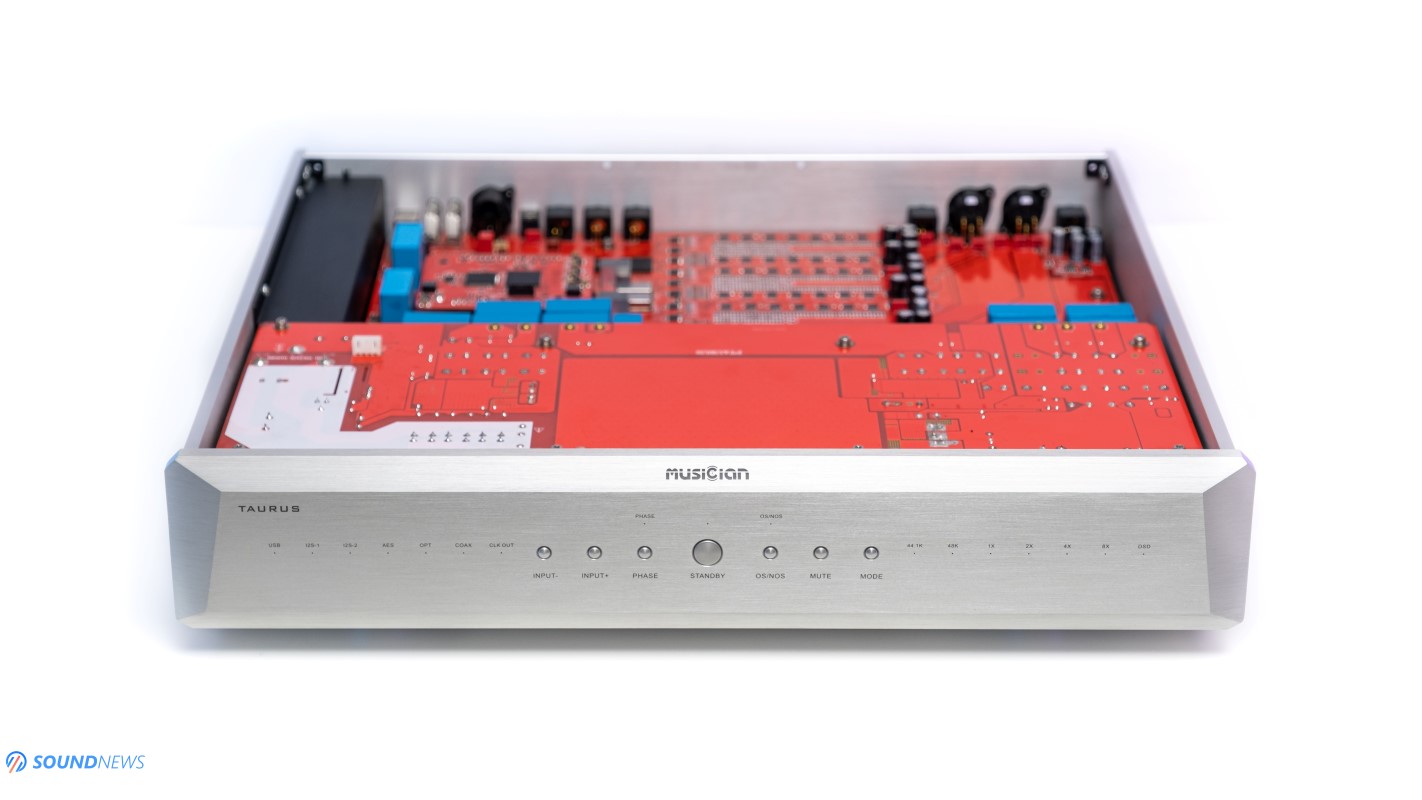
My Conclusion
Before unleashing my thoughts on the Musician Aquarius DAC, let’s recall my earlier words about it: “I wouldn’t describe it as warm, thick, meaty, bright, lean, or mellow sounding; it doesn’t have any of that.” Taurus, on the other hand, is a whole different beast. It’s devoid of brightness and listening fatigue like the Aquarius was in its heyday, yet it boasts a thicker, sweeter, and meatier character compared to anything Musician Audio has done so far.
But wait, there’s more! I can boldly say I haven’t encountered a more entertaining-sounding DAC for reviewing purposes this whole year. The R2R character is rocking the house, and the tonal richness is spilling over its circuit boards like a waterfall. If you’re transitioning from a Musician Aquarius or Pegasus, then Taurus just might be the upgrade you’ve been waiting for. It’s bigger, wider, and sounds like a concert on all axes, while gently boosting resolution and dynamic range. It still has the familiar Musician Audio house sound, just more refined with extra nuances on the micro-scale and scarier dynamics when the volume cranks up.
Now, let’s address the elephant in the room—it’s a DAC-only unit with no fancy extras. Say goodbye to flashy displays, touch controls, beautiful UIs, and a plethora of functions to play with. It’s a specialist, and boy, does it specialize well! At the end of the day, Taurus formed a stronger bond with my tunes than I expected, and that’s one reason why I’m behind schedule with this review. I’ve been grooving to music instead of penning sound impressions, and if that’s not a testament to its performance, then I don’t know what is.
Musician’s Taurus comes with a hefty price tag of $3800. Crazy, right? But consider this: it’s two and a half times heavier than the $2800 Aquarius, its single-crystal copper transformer is four times as big and powerful, and it flaunts a more complex layout with daughter boards and higher quality components all around. The price bump from the Aquarius seems minuscule in comparison. Sure, it’s a wild notion to call a $3800 DAC affordable these days when you can find good-measuring units for the price of a pair of interconnect cables. However, in my humble opinion, Musician’s Taurus performs above its asking price, making it a strong contender for an end-game R2R DAC. Its price was fully justified, and I don’t spot lots of competitors on the horizon, deserving our stamp of approval and, of course, our highest award.

Now, for a little extra treat for our readers worldwide, I’ve teamed up with Musician Audio and their global distributor Aoshida-Audio for a 10% discount! Just add it to your cart (here’s the product link) and use the “Soundnews” discount code from November 30th to December 7th, 2023, and enjoy a whopping $380 off. Let us know in the comment section below if it met or exceeded your expectations.
That’s all for now, folks! I hope you enjoyed this review of the Musician Taurus DAC. If you have any questions or comments, feel free to leave them below. Sandu’s signing off!
PROS:
- Massive & weighty, that’s a plus for me
- Solid build quality that follows Musician’s design language
- Oversized power supply implementation, great component selection
- Finally, an industry-standard output of 4.3V via XLR and 2.5V via RCA
- Fully balanced and fully discrete input to output stages
- The widest and deepest soundstage I have experienced so far
- Deep and holographic sounding in both a stereo and head-fi setup
- Noiseless sounding in both a stereo and head-fi setup
- The resolution went up by a notch, rivaling pricier converters
- Full-bodied, tonally rich, sweet, and organic sounding most of the time
- Tames brightness and listening fatigue without removing resolution from the upper treble
- Toe-tapping and highly addictive
- Dynamics and transients were always impressive
- Widest selection of digital inputs
- Offers a great price-to-performance ratio
CONS:
- It’s a DAC-only unit with zero additional features
- Forget flashy displays, remote controls, or complex UIs
- You’ll need a preamp for your power amp
ASSOCIATED EQUIPMENT:
- DACs: Musician Audio Taurus, Rockna Wavedream Signature, Chord Electronics DAVE, Gold Note DS-10 PLUS
- Wireless Streamer & Music Server: Rockna Wavedream NET 4TB, EverSolo DMP-A8
- DDCs: Singxer SU-6, Matrix X-SPDIF 3
- Headphone Amps: Trafomatic Primavera, Enleum AMP-23R, Ferrum OOR & HYPSOS, Burson Soloist 3X GT 2023, Flux Lab Acoustics Volot
- IEMs: HiFiMan Svanar, Westone Mach 50, Hiby ZETA, Meze Rai Penta, FiiO FX15 & FH9, 7Hz Timeless AE, Kinera Skuld & others
- Full-sized headphones: HiFiMan Susvara, Arya Organic, Audivina, Ananda Nano, Meze Elite & 109 PRO, Erzetich Charybdis & Phobos V.2021, Sennheiser HD800S, Kennerton Rognir (planar) & Vali, Apos Caspian, Sendy Peacock & Apollo, FiiO FT5, HarmonicDyne Elite & Poseidon, Moondrop Venus & others
- Preamps: Chord Electronics Ultima 3 Pre
- Power Amps: Chord Electronics Ultima 5 Power, Burson Timekeeper 3X GT (x2)
- Loudspeakers: KEF Reference 3, Raidho TD2.2 (incoming)
- DAC/Amps: xDuoo XD05 PRO, Shanling H7, FiiO Q7, Topping G5
- DAPs: HiBy RS8, FiiO M15S, Shanling M6 Ultra
- Interconnects: Crystal Cable Reference2 Diamond (x3), QED Reference (x2), Topping TCX1 (x2)
- USB Cables: Supra USB Excalibur (x2), Chord C-USB, Matrix Hi-Fi USB
- HDMI Cables: Audioquest Diamond DBS, Supra 8K HDMI
- Speaker cables: Kimber PR8, Audioquest Type4
- Power Cables: Crystal Cable Reference2 Diamond (x3), Isotek EVO3 Premier (x2), iFi Audio SupaNova (x2)
- Balanced Isolation Power Conditioners: PLiXiR Elite BAC1500 (stereo setup), KECES IQRP-1500 and P14 (headphone setup)


